简奥斯汀英文简介及作品评论
- 格式:docx
- 大小:18.18 KB
- 文档页数:4
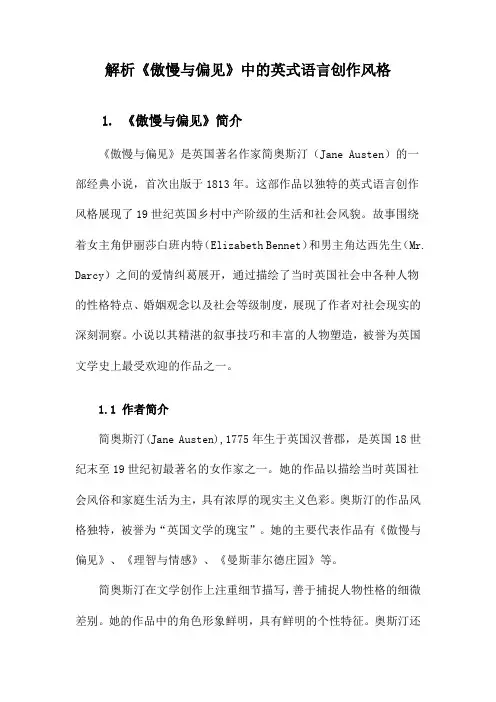
解析《傲慢与偏见》中的英式语言创作风格1. 《傲慢与偏见》简介《傲慢与偏见》是英国著名作家简奥斯汀(Jane Austen)的一部经典小说,首次出版于1813年。
这部作品以独特的英式语言创作风格展现了19世纪英国乡村中产阶级的生活和社会风貌。
故事围绕着女主角伊丽莎白班内特(Elizabeth Bennet)和男主角达西先生(Mr. Darcy)之间的爱情纠葛展开,通过描绘了当时英国社会中各种人物的性格特点、婚姻观念以及社会等级制度,展现了作者对社会现实的深刻洞察。
小说以其精湛的叙事技巧和丰富的人物塑造,被誉为英国文学史上最受欢迎的作品之一。
1.1 作者简介简奥斯汀(Jane Austen),1775年生于英国汉普郡,是英国18世纪末至19世纪初最著名的女作家之一。
她的作品以描绘当时英国社会风俗和家庭生活为主,具有浓厚的现实主义色彩。
奥斯汀的作品风格独特,被誉为“英国文学的瑰宝”。
她的主要代表作品有《傲慢与偏见》、《理智与情感》、《曼斯菲尔德庄园》等。
简奥斯汀在文学创作上注重细节描写,善于捕捉人物性格的细微差别。
她的作品中的角色形象鲜明,具有鲜明的个性特征。
奥斯汀还擅长运用讽刺手法,对当时社会的种种弊端进行批判。
她的作品不仅具有很高的文学价值,还为后世的作家提供了丰富的创作灵感。
1.2 作品背景英国作家简奥斯汀(Jane Austen)创作的长篇小说《傲慢与偏见》是其文学史上的瑰宝。
小说以当时的英国社会背景作为创作的舞台,真实地展现了那个时代的情感和社会面貌。
十八世纪末期的英国,正处于工业革命的前夕,整个社会正处于新旧交替的过渡阶段。
在乡村社会和经济关系不断变化的背景下,小说通过描写年轻男女间的情感纠葛和婚姻问题,折射出了英国社会普遍的价值观和风俗习惯。
小说的语言创作风格,深受当时的社会语境和文学风格的影响,呈现出独特的英式语言特色。
奥斯汀的作品被认为是英国古典文学的杰作之一,不仅继承发展了欧洲传统的文学作品风格,还融入了当时英国社会的时代特征。

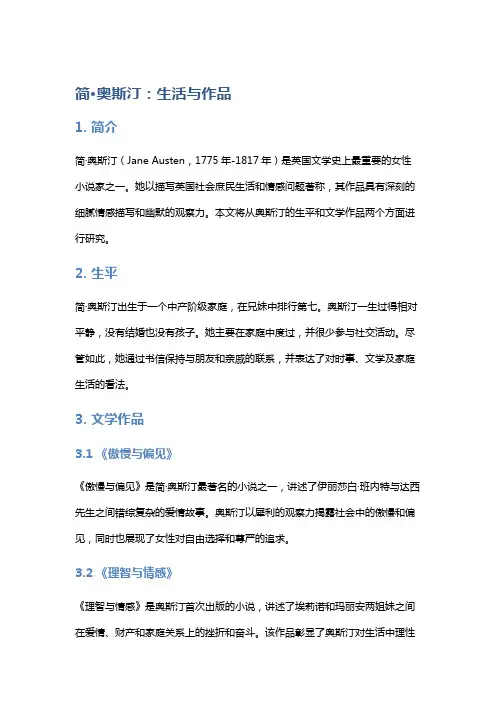
简·奥斯汀:生活与作品1. 简介简·奥斯汀(Jane Austen,1775年-1817年)是英国文学史上最重要的女性小说家之一。
她以描写英国社会庶民生活和情感问题著称,其作品具有深刻的细腻情感描写和幽默的观察力。
本文将从奥斯汀的生平和文学作品两个方面进行研究。
2. 生平简·奥斯汀出生于一个中产阶级家庭,在兄妹中排行第七。
奥斯汀一生过得相对平静,没有结婚也没有孩子。
她主要在家庭中度过,并很少参与社交活动。
尽管如此,她通过书信保持与朋友和亲戚的联系,并表达了对时事、文学及家庭生活的看法。
3. 文学作品3.1 《傲慢与偏见》《傲慢与偏见》是简·奥斯汀最著名的小说之一,讲述了伊丽莎白·班内特与达西先生之间错综复杂的爱情故事。
奥斯汀以犀利的观察力揭露社会中的傲慢和偏见,同时也展现了女性对自由选择和尊严的追求。
3.2 《理智与情感》《理智与情感》是奥斯汀首次出版的小说,讲述了埃莉诺和玛丽安两姐妹之间在爱情、财产和家庭关系上的挫折和奋斗。
该作品彰显了奥斯汀对生活中理性思考与情感表达之间的关系有着独特见解,并深入探讨了社会压力、经济实用主义与人性善良之间的矛盾。
3.3 其他作品除了以上两部作品,简·奥斯汀还创作了一系列其他优秀小说,如《诺桑觉寺》、《劝导》等。
这些作品都以其细腻入微地描绘人物心理和社会风貌而闻名于世。
4. 影响简·奥斯汀的作品不仅在当时引起了广泛关注,而且至今仍然受到全球读者的热爱。
她对小说写作的贡献在于将庶民生活和真实感情带入文学作品,打破当时对于女性作家的刻板印象。
她塑造的深入人心的角色和细腻入微的情感描写成为后世文学创作的重要参考。
5. 结语简·奥斯汀以她细腻独到的文笔,以及对社会庶民生活和情感问题的洞察力,在英国和全球文学界留下了不可磨灭的印记。
通过研究奥斯汀的生平和作品,我们可以更好地理解这位杰出女作家所承载的思想与价值观,并欣赏她独特、雅致而又充满智慧的写作风格。
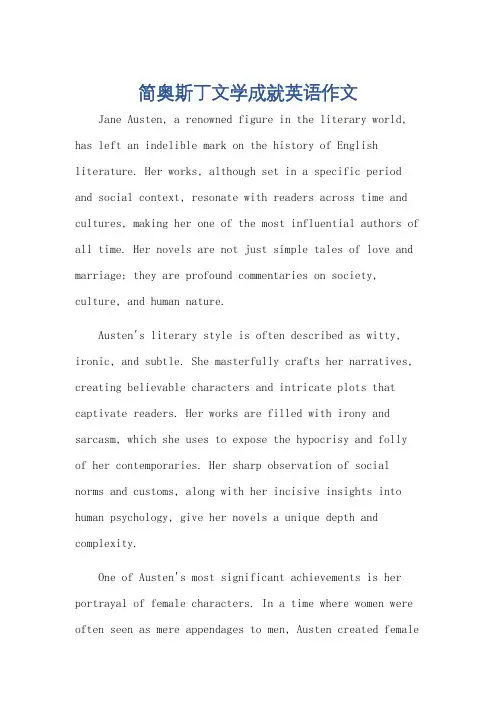
简奥斯丁文学成就英语作文Jane Austen, a renowned figure in the literary world, has left an indelible mark on the history of English literature. Her works, although set in a specific period and social context, resonate with readers across time and cultures, making her one of the most influential authors of all time. Her novels are not just simple tales of love and marriage; they are profound commentaries on society, culture, and human nature.Austen's literary style is often described as witty, ironic, and subtle. She masterfully crafts her narratives, creating believable characters and intricate plots that captivate readers. Her works are filled with irony and sarcasm, which she uses to expose the hypocrisy and folly of her contemporaries. Her sharp observation of social norms and customs, along with her incisive insights into human psychology, give her novels a unique depth and complexity.One of Austen's most significant achievements is her portrayal of female characters. In a time where women were often seen as mere appendages to men, Austen created femaleprotagonists who are intelligent, independent, and assertive. Her heroines, such as Elizabeth Bennet in "Pride and Prejudice" and Emma Woodhouse in "Emma," are not just passive victims of circumstance; they are active agents who shape their own destinies. Austen's female characters are also complex and multifaceted, displaying a range of emotions and traits that were uncommon in female characters of her time.Another noteworthy aspect of Austen's writing is her exploration of themes such as social class, marriage, and morality. Her novels are filled with commentary on the social hierarchy and the role of marriage in determining one's social status. Austen critiques the institution of marriage,暴露其背后的经济和社会考量,同时探讨了真正的爱情和婚姻应该如何建立。
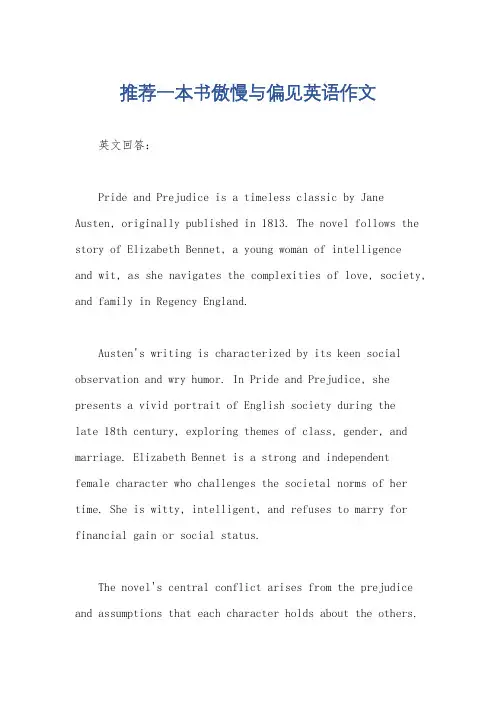
推荐一本书傲慢与偏见英语作文英文回答:Pride and Prejudice is a timeless classic by Jane Austen, originally published in 1813. The novel follows the story of Elizabeth Bennet, a young woman of intelligenceand wit, as she navigates the complexities of love, society, and family in Regency England.Austen's writing is characterized by its keen social observation and wry humor. In Pride and Prejudice, she presents a vivid portrait of English society during thelate 18th century, exploring themes of class, gender, and marriage. Elizabeth Bennet is a strong and independent female character who challenges the societal norms of her time. She is witty, intelligent, and refuses to marry for financial gain or social status.The novel's central conflict arises from the prejudice and assumptions that each character holds about the others.Elizabeth is initially prejudiced against Mr. Darcy, a wealthy and proud landowner, due to his arrogant demeanor. Darcy, in turn, is prejudiced against Elizabeth because of her family's lower social status. As the story progresses, both Elizabeth and Darcy must overcome their initial prejudices and learn to appreciate each other's true worth.Pride and Prejudice is a beloved classic that continues to be enjoyed by readers today. Austen's witty andinsightful writing, coupled with her well-developed characters and timeless themes, make Pride and Prejudice a timeless masterpiece.中文回答:《傲慢与偏见》推荐。



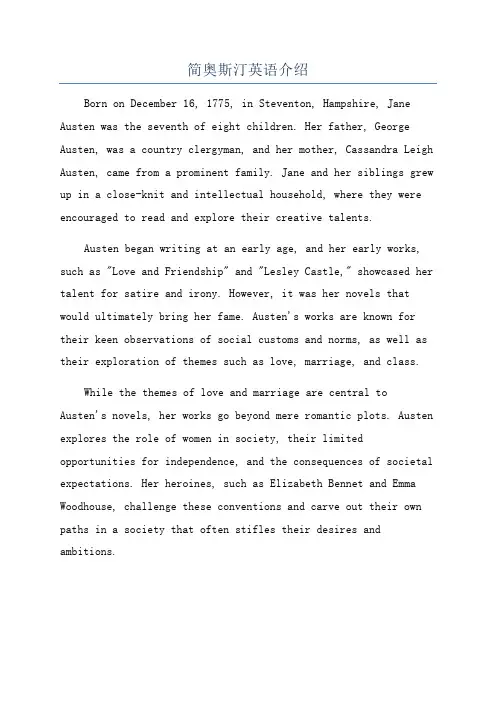
简奥斯汀英语介绍Born on December 16, 1775, in Steventon, Hampshire, Jane Austen was the seventh of eight children. Her father, George Austen, was a country clergyman, and her mother, Cassandra Leigh Austen, came from a prominent family. Jane and her siblings grew up in a close-knit and intellectual household, where they were encouraged to read and explore their creative talents.Austen began writing at an early age, and her early works, such as "Love and Friendship" and "Lesley Castle," showcased her talent for satire and irony. However, it was her novels that would ultimately bring her fame. Austen's works are known for their keen observations of social customs and norms, as well as their exploration of themes such as love, marriage, and class.While the themes of love and marriage are central toAusten's novels, her works go beyond mere romantic plots. Austen explores the role of women in society, their limited opportunities for independence, and the consequences of societal expectations. Her heroines, such as Elizabeth Bennet and Emma Woodhouse, challenge these conventions and carve out their own paths in a society that often stifles their desires and ambitions.。
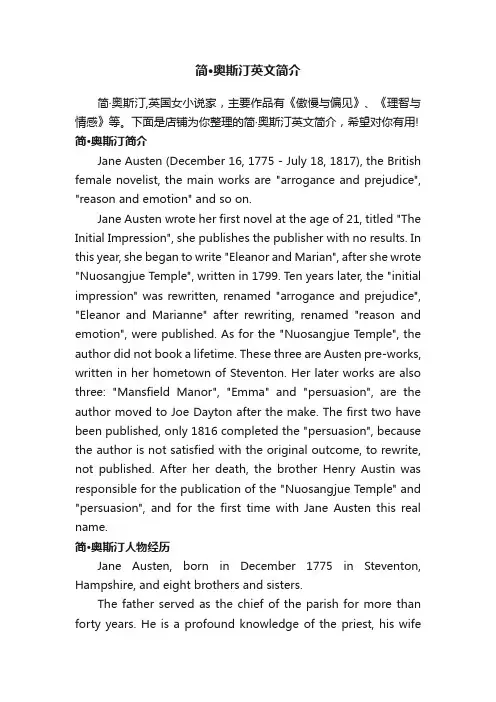
简·奥斯汀英文简介简·奥斯汀,英国女小说家,主要作品有《傲慢与偏见》、《理智与情感》等。
下面是店铺为你整理的简·奥斯汀英文简介,希望对你有用! 简·奥斯汀简介Jane Austen (December 16, 1775 - July 18, 1817), the British female novelist, the main works are "arrogance and prejudice", "reason and emotion" and so on.Jane Austen wrote her first novel at the age of 21, titled "The Initial Impression", she publishes the publisher with no results. In this year, she began to write "Eleanor and Marian", after she wrote "Nuosangjue Temple", written in 1799. Ten years later, the "initial impression" was rewritten, renamed "arrogance and prejudice", "Eleanor and Marianne" after rewriting, renamed "reason and emotion", were published. As for the "Nuosangjue Temple", the author did not book a lifetime. These three are Austen pre-works, written in her hometown of Steventon. Her later works are also three: "Mansfield Manor", "Emma" and "persuasion", are the author moved to Joe Dayton after the make. The first two have been published, only 1816 completed the "persuasion", because the author is not satisfied with the original outcome, to rewrite, not published. After her death, the brother Henry Austin was responsible for the publication of the "Nuosangjue Temple" and "persuasion", and for the first time with Jane Austen this real name.简·奥斯汀人物经历Jane Austen, born in December 1775 in Steventon, Hampshire, and eight brothers and sisters.The father served as the chief of the parish for more than forty years. He is a profound knowledge of the priest, his wifewas born in the more wealthy family, but also has a certain cultural accomplishment. Therefore, although Austin did not enter the formal school, but the family's excellent conditions and reading environment, gave her self-learning conditions, cultivate her writing interest. She began to write something at the age of thirteen, showing her talent in language. In 1800 the father retired, the family moved to Bath, Austin does not like this place, she was said to have suffered torture torture. Here, Austin rejected a young man who would inherit the great fortune, because she did not love him. Lived for four years or so, his father died in the place, so Austin and mother, sister and moved to Southampton, 1809 and then moved to Jordon. In early 1816 she was seriously ill, the body is weakening, in May 1817 was sent to Winchester for treatment, but the treatment is invalid, in the same year on July 18 died in her sister's arms. She was unmarried for the rest of her life and was buried in Winchester Cathedral. 简·奥斯汀创作特点Theme of the workAustin's characters are fictional, but they all reflect Austen's own view of marriage. The changes in the era of Austin life, social, economic and political changes have affected the various classes. At that time, the rural aristocracy and the landlord youth also reflected some ideas on human nature and humanity after the rise of the Renaissance. For example, "arrogance and prejudice" in the Elizabeth fully embodies Austen's longing for the love and marriage model, Elizabeth and Darcy in the exchanges, advocating the principle of equality between men and women, abandon the traditional male superiority view, and that noble feelings are people's normal need. At the same time, Austin's ideal marriage in addition to equality, respect, there is freedomand understanding, she hopes to help people get rid of the shackles of traditional thinking, to find themselves, to achieve self.Artistic characteristicsAusten's style of work is so witty, full of comedy. Because Austin life for the rest of his life in the feudal forces of the powerful village, coupled with well-off family, so the circle of life is very small. Which makes her works are often confined to the ordinary gentry daughter love the story of marriage, and her works to some extent reflect the feudal forces point of view. The work mainly through the ladies gentlemen's social communication, daily dialogue to reflect the family and social moral standards. Which makes Austen's work for a long time considered to be popular books. However, although Austen's work is likened to "two-inch ivory carvings", but she still through the gentleman's daily conversation and communication to reflect the social attitudes at that time, with humorous language to irony mercenary, love vanity phenomenon , Through the comic scenes ridicule people stupid, selfish, snobbish and blind self-confidence and other ridiculous weaknesses.。
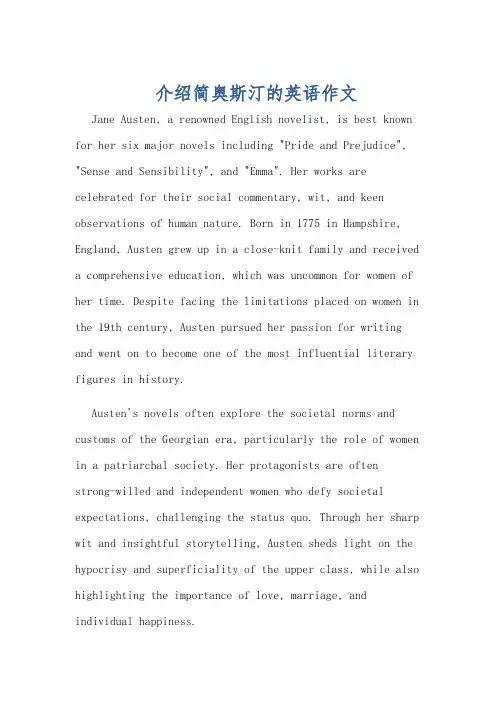
介绍简奥斯汀的英语作文Jane Austen, a renowned English novelist, is best known for her six major novels including "Pride and Prejudice", "Sense and Sensibility", and "Emma". Her works are celebrated for their social commentary, wit, and keen observations of human nature. Born in 1775 in Hampshire, England, Austen grew up in a close-knit family and received a comprehensive education, which was uncommon for women of her time. Despite facing the limitations placed on women in the 19th century, Austen pursued her passion for writing and went on to become one of the most influential literary figures in history.Austen's novels often explore the societal norms and customs of the Georgian era, particularly the role of women in a patriarchal society. Her protagonists are oftenstrong-willed and independent women who defy societal expectations, challenging the status quo. Through her sharp wit and insightful storytelling, Austen sheds light on the hypocrisy and superficiality of the upper class, while also highlighting the importance of love, marriage, and individual happiness.One of Austen's most beloved works, "Pride and Prejudice", is a timeless classic that continues to captivate readers around the world. The novel follows the tumultuous relationship between Elizabeth Bennet and Mr. Darcy, and is celebrated for its sharp social commentary, memorable characters, and enduring romance. Austen's keen understanding of human nature and her ability to craft compelling narratives have solidified her reputation as a literary genius.In addition to her literary achievements, Austen's personal life and experiences have also contributed to her enduring legacy. Though she never married, her letters and personal writings reveal a keen sense of humor and a deep understanding of human emotions. Her portrayal of love and relationships in her novels is often seen as a reflection of her own views and experiences, adding depth and authenticity to her work.In conclusion, Jane Austen's impact on literature and popular culture is immeasurable. Her timeless novels continue to inspire and entertain readers of all ages, and her legacy as a pioneering female author lives on. Throughher insightful social commentary and memorable characters, Austen's work remains as relevant and beloved today as it was during her lifetime.简·奥斯汀,一位著名的英国小说家,以她的六部主要小说《傲慢与偏见》、《理智与情感》和《艾玛》而闻名。
你自己看一下,提取你认为要演讲的东西。
读一遍对你有好处,等演讲完了别人问你问题也好回答。
Jane Austen (1775-1817)English writer, who first gave the novel its modern character through the treatment of everyday life. Although Austen was widely read in her lifetime, she published her works anonymously. The most urgent preoccupation of her bright, young heroines is courtship and finally marriage. Austen herself never married. Her best-known books include PRIDE AND PREJUDICE (1813) and EMMA (1816). Virginia Woolf called Austen "the most perfect artist among women.""It is a truth universally acknowledged, that a single man in possession of a good fortune, must be in want of a wife." (from Pride and Prejudice, 1813)Jane Austen was born in Steventon, Hampshire, where her father, Rev. George Austen, was a rector. She was the second daughter and seventh child in a family of eight. The Austens did not lose a single one of their children. Cassandra Leigh, Jane's mother, fed her infants at the breast a few months, and then sent them to a wet nurse in a nearby village to be looked after for another year or longer.The first 25 years of her life Jane spent in Hampshire. On her father's unexpected retirement, the family sold off everything, including Jane's piano, and moved to Bath. Jane, aged twenty-five, and Cassandra, her elder sister, aged twenty-eight, were considered by contemporary standards confirmed old maid, and followed their parents.Jane Austen was mostly tutored at home, and irregularly at school, but she received a broader education than many women of her time. She started to write for family amusement as a child. Her parents were avid readers; Austen's own favorite poet was Cowper. Her earliest-known writings date from about 1787. Very shy about her writing, she wrote on small pieces of paper that she slipped under the desk plotter if anyone came into the room. In her letters she observed the daily life of her family and friends in an intimate and gossipy manner: "James danced with Alethea, and cut up the turkey last night with great perseverance. You say nothing of the silk stockings; I flatter myself, therefore, that Charles has not purchased any, as I cannot very well afford to pay for them; all my money is spent in buying white gloves and pink persian." (Austen in a letter to her sister Cassandra in 1796)Austen's father supported his daughter's writing aspirations and tried to help her get a publisher. After his death in 1805, she lived with her sister and hypochondriac mother in Southampton and moved in 1809 to a large cottage in the village of Chawton. Austen never married, but her social life was active and she had suitors and romantic dreams. James Edward Austen-Leigh, her nephew, wanted to create another kind of legend around her and claimed that "of events her life was singularly barren: few changes and no great crises ever broke the smooth current of its course... There was in her nothing eccentric or angular; no ruggedness of temper; no singularity of manner..." Austen's sister Cassandra also never married. One of her brothers became a clergyman, two served in the navy, one was mentally retarded. He was taken care of a local family.Austen was well connected with the middling-rich landed gentry that she portrayed in her novels.In Chawton she started to write her major works, among them SENSE AND SENSIBILITY, the story of the impoverished Dashwood sisters, Marianne and Elinor, who try to find proper husbands to secure their social position. The novel was written in 1797 as the revision of a sketch called Elinor and Marianne, composed when the author was 20. According to some sources, an earlier version of the work was written in the form of a novel in letters, and read aloud to the family as early as 1795.Austen's heroines are determined to marry wisely and well, but romantic Marianne of Sense and Sensibility is a character, who feels intensely about everything and loses her heart to an irresponsible seducer. "I could not be happy with a man whose taste did not in every point coincide with my own. He must enter into all my feelings; the same with books, the same music must charm us both." Reasonable Elinor falls in love with a gentleman already engaged. '"I have frequently detected myself in such kind of mistakes," said Elinor, "in a total misapprehension of character in some point or another: fancying people so much more gay or grave, or ingenious or stupid than they really are, and I can hardly tell why or in what the deception originated. Sometimes one is guided by what they say of themselves, and very frequently by what other people say of them, without giving oneself time to deliberate and judge."' When Marianne likes to read and express her feelings, Elinor prefers to draw and design and be silent of his desires. They are the daughters of Henry Dashwood, whose son, John, from a former marriage. After his death, John inherits the Norland estate in Sussex, where the sisters live. John's wife, the greedy and selfish Fanny, insists that they move to Norland. The impoverished widow and and her daughters move to Barton Cottage in Devonshire. There Marianne is surrounded by a devious heartbreaker Willoughby, who has already loved another woman. Elinor becomes interested in Edward Ferrars, who is proud and ignorant. Colonel Brandon, an older gentleman, doesn't attract Marianne. She is finally rejected by Willoughby. "Marianne Dashwood was born to an extraordinary fate. She was born to discover the falsehood of her own opinions, and to counteract, by her conduct, her most favorite maxims."In all of Austen's novels her heroines are ultimately married. Pride and Prejudice described the clash between Elisabeth Bennet, the daughter of a country gentleman and an intelligent young woman, and Fitzwilliam Darcy, a rich aristocratic landowner. Their relationship starts from dislike, but Darcy becomes intrigued by her mind and spirit. At last they fall in love and are happily united. Austen had completed the early version of the story in 1797 under the title "First Impressions". The book went to three printings during Austen's lifetime. In 1998 appeared a sequel to the novel, entitled Desire and Duty, written by Teddy F. Bader, et al. It followed the ideas Jane Austen told her family.Emma was written in comic tone. Austen begun the novel in January 1814 and completed it in March of the next year. The book was published in three volumes. It told the story of Emma Woodhouse, who finds her destiny in marriage. Emma is a wealthy, pretty, self-satisfied young woman. She is left alone with her hypochondriac father. Her governess, Miss Taylor, marries a neighbor, Mr. Weston. Emma has too much time and she spends it choosing proper partners for her friends and neighbors - blind to her own feelings. She makes a protégée of Harriet Smith, an illegitimate girl of no social status and tries to manipulate a marriage between Harriet and Mr. Elton, a young clergyman, who has set his sight on Emma. Emma has feelings about Mr. Weston's son. When Harriet becomes interested in George Knightley, a neighboring squire who has been her friend, Emma starts to understand her own limitations. He has been her moral adviser, and secretly lovesher. Finally Emma finds her destiny in marriage with him. Harriet, who is left to decide for herself, marries Robert Martin, a young farmer.Austen focused on middle-class provincial life with humor and understanding. She depicted minor landed gentry, country clergymen and their families, in which marriage mainly determined women's social status. Most important for her were those little matters, as Emma says, "on which the daily happiness of private life depends." Although Austen restricted to family matters, and she passed the historical events of the Napoleonic wars, her wit and observant narrative touch has been inexhaustible delight to readers. Of her six great novels, four were published anonymously during her lifetime. Austen also had troubles with her publisher, who wanted to make alterations to her love scenes in Pride and Prejudice. In 1811 he wrote to Thomas Egerton: "You say the book is indecent. You say I am immodest. But Sir in the depiction of love, modesty is the fullness of truth; and decency frankness; and so I must also be frank with you, and ask that you remove my name from the title page in all future printings; 'A lady' will do well enough." At her death on July 18, 1817 in Winchester, at the age of forty-one, Austen was writing the unfinished SANDITON. She managed to write twelve chapters before stopping in March 18, due to her poor health.Austen was buried in Winchester Cathedral, near the centre of the north aisle. "It is a satisfaction to me to think that [she is] to lie in a Building she admired so much," Austen's sister Cassandra wrote later. Cassandra destroyed many of her sister's letters; one hundred sixty survived but none written earlier than her tentieth birthday.Austen's brother Henry made her authorship public after her death. Emma had been reviewed favorably by Sir Walter Scott, who wrote in his journal of March 14, 1826: "[Miss Austen] had a talent for describing the involvements and feelings and characters of ordinary life which is to me the most wonderful I have ever met with. The Big Bow-Wow strain I can do myself like any now going; but the exquisite touch, which renders ordinary commonplace things and characters interesting, from the truth of the description and the sentiment, is denied to me." Charlotte Brontë and E.B. Browning found her limited, and Elizabeth Hardwick said: "I don't think her superb intelligence brought her happiness." It was not until the publication of J.E. Austen-Leigh's Memoir in 1870 that a Jane Austen cult began to develop. Austen's unfinished Sanditon was published in 1925.For further reading: Memoirs by J.E. Austen-Leigh (1870); Jane Austen and Her World by Mary Lascelles (1939); Jane Austen and Her Art by M. Lascalles (1941); Jane Austen by R.W. Chapman (1948); The Novels of Jane Austen by Robert Liddell (1963); The Language of Jane Austen by N. Page (1972); The Double Life of Jane Austen by Jane Hodge (1972); The Critical Heritage, ed. by B. Southam (1987); Jane Austen by Claudia L. Johnson (1990); Erotic Faith by Robert M. Polhemus (1990); Jane Austen's Novels by Roger Gard (1992); The Cambridge Companion to Jane Austen, ed. by Edward Copeland, Juliet McMaster (1997); Jane Austen, Obstinate Heart by Valerie Grosvenor Myer (1997); Jane Austen: Her Life by Park Honan (1997); Jane Austen: A Life by David Nokes (1998); Jane Austen: A Life by Claire Tomalin (1998); A History of Jane Austen's Family by George Holbert Tucker (1998); Critical Essays of Jane Austen, ed. by Laura Mooneyham (1998); Jane Austen by Deirdre Le Faye (1998); The Author's Inheritance: Henry Fielding, Jane Austen, andthe Establishment of the Novel by Jo Alyson Parker (1998); Pride & Promiscuity: The Lost Sex Scenes of Jane Austen by Arielle Eckstut, Dennis Ashton (2001); Jane Austen by Carol Shields (2001) - See also: J.F. Cooper - Museum: Jane Austen's House, Chawton, Alton, GU34 ISD. - Austen wrote Mansfield Park, Emma, and Persuasion while living in this house.。
简奥斯汀的简介简·奥斯汀,19世纪英国小说家,世界文学史上最具影响力的女性文学家之一,下面是店铺搜集整理的简奥斯汀的简介,希望对你有帮助。
简奥斯汀的简介简·奥斯汀(英语:Jane Austen,1775年12月16日-1817年7月18日),其最著名的作品是《傲慢与偏见》和《理智与情感》。
她的作品主要关注乡绅家庭女性的婚姻和生活,以女性特有的细致入微的观察力和活泼风趣的文字真实地描绘了她周围世界的小天地。
她在后期著名作品有三部:《曼斯菲尔德庄园》、《爱玛》和《劝导》,都是作者迁居乔顿以后所作。
前两部先后出版,只有1816年完成的《劝导》,因为作者对原来的结局不满意,要重写,没有出版过。
她病逝以后,哥哥亨利·奥斯汀负责出版了《诺桑觉寺》和《劝导》,并且第一次用了简·奥斯汀这个真名。
2017年起将取代生物学家达尔文,成为10英镑新钞的肖像人物。
简奥斯汀的文学特点由于奥斯汀终其一生都生活在封建势力强大的乡村,加之家境殷实,所以生活圈子很小。
这使得她的作品往往局限于普通乡绅的女儿恋爱结婚的故事当中,而她的作品也从某种程度上反映出了封建势力的观点。
作品主要通过淑女绅士们的社会交际,日常对话来反映家庭和社会的道德标准。
这使得奥斯汀的作品很长一段时间都被认为是通俗读物。
但是,尽管奥斯汀的作品被比喻为“两寸象牙雕”,但是她仍然通过身世太太们的日常对话交际来反映出了当时的社会百态,用幽默的语言来讽刺了惟利是图,爱慕虚荣的现象。
简奥斯汀的创作生平简·奥斯汀英国女小说家。
父亲是当地教区牧师。
奥斯汀没有上过正规学校,但受到较好的家庭教育,主要教材就是父亲的文学藏书。
奥斯汀一家爱读流行小说,多半是庸俗的消遣品。
她少女时期的习作就是对这类流行小说的滑稽模仿,这样就形成了她作品中嘲讽的基调。
她20岁左右开始写作,共发表了6部长篇小说。
1811年出版的《理智与情感》是她的处女作,随后又接连发表了《傲慢与偏见》(1813)、《曼斯菲尔德花园》(1814)和《爱玛》(1815)。
你自己看一下,提取你认为要演讲的东西。
读一遍对你有好处,等演讲完了别人问你问题也好回答。
Jane Austen (1775-1817)English writer, who first gave the novel its modern character through the treatment of everyday life. Although Austen was widely read in her lifetime, she published her works anonymously. The most urgent preoccupation of her bright, young heroines is courtship and finally marriage. Austen herself never married. Her best-known books include PRIDE AND PREJUDICE (1813) and EMMA (1816). Virginia Woolf called Austen "the most perfect artist among women.""It is a truth universally acknowledged, that a single man in possession of a good fortune, must be in want of a wife." (from Pride and Prejudice, 1813)Jane Austen was born in Steventon, Hampshire, where her father, Rev. George Austen, was a rector. She was the second daughter and seventh child in a family of eight. The Austens did not lose a single one of their children. Cassandra Leigh, Jane's mother, fed her infants at the breast a few months, and then sent them to a wet nurse in a nearby village to be looked after for another year or longer.The first 25 years of her life Jane spent in Hampshire. On her father's unexpected retirement, the family sold off everything, including Jane's piano, and moved to Bath. Jane, aged twenty-five, and Cassandra, her elder sister, aged twenty-eight, were considered by contemporary standards confirmed old maid, and followed their parents.Jane Austen was mostly tutored at home, and irregularly at school, but she received a broader education than many women of her time. She started to write for family amusement as a child. Her parents were avid readers; Austen's own favorite poet was Cowper. Her earliest-known writings date from about 1787. Very shy about her writing, she wrote on small pieces of paper that she slipped under the desk plotter if anyone came into the room. In her letters she observed the daily life of her family and friends in an intimate and gossipy manner: "James danced with Alethea, and cut up the turkey last night with great perseverance. You say nothing of the silk stockings; I flatter myself, therefore, that Charles has not purchased any, as I cannot very well afford to pay for them; all my money is spent in buying white gloves and pink persian." (Austen in a letter to her sister Cassandra in 1796)Austen's father supported his daughter's writing aspirations and tried to help her get a publisher. After his death in 1805, she lived with her sister and hypochondriac mother in Southampton and moved in 1809 to a large cottage in the village of Chawton. Austen never married, but her social life was active and she had suitors and romantic dreams. James Edward Austen-Leigh, her nephew, wanted to create another kind of legend around her and claimed that "of events her life was singularly barren: few changes and no great crises ever broke the smooth current of its course... There was in her nothing eccentric or angular; no ruggedness of temper; no singularity of manner..." Austen's sister Cassandra also never married. One of her brothers became a clergyman, two served in the navy, one was mentally retarded. He was taken care of a local family.Austen was well connected with the middling-rich landed gentry that she portrayed in her novels.In Chawton she started to write her major works, among them SENSE AND SENSIBILITY, the story of the impoverished Dashwood sisters, Marianne and Elinor, who try to find proper husbands to secure their social position. The novel was written in 1797 as the revision of a sketch called Elinor and Marianne, composed when the author was 20. According to some sources, an earlier version of the work was written in the form of a novel in letters, and read aloud to the family as early as 1795.Austen's heroines are determined to marry wisely and well, but romantic Marianne of Sense and Sensibility is a character, who feels intensely about everything and loses her heart to an irresponsible seducer. "I could not be happy with a man whose taste did not in every point coincide with my own. He must enter into all my feelings; the same with books, the same music must charm us both." Reasonable Elinor falls in love with a gentleman already engaged. '"I have frequently detected myself in such kind of mistakes," said Elinor, "in a total misapprehension of character in some point or another: fancying people so much more gay or grave, or ingenious or stupid than they really are, and I can hardly tell why or in what the deception originated. Sometimes one is guided by what they say of themselves, and very frequently by what other people say of them, without giving oneself time to deliberate and judge."' When Marianne likes to read and express her feelings, Elinor prefers to draw and design and be silent of his desires. They are the daughters of Henry Dashwood, whose son, John, from a former marriage. After his death, John inherits the Norland estate in Sussex, where the sisters live. John's wife, the greedy and selfish Fanny, insists that they move to Norland. The impoverished widow and and her daughters move to Barton Cottage in Devonshire. There Marianne is surrounded by a devious heartbreaker Willoughby, who has already loved another woman. Elinor becomes interested in Edward Ferrars, who is proud and ignorant. Colonel Brandon, an older gentleman, doesn't attract Marianne. She is finally rejected by Willoughby. "Marianne Dashwood was born to an extraordinary fate. She was born to discover the falsehood of her own opinions, and to counteract, by her conduct, her most favorite maxims."In all of Austen's novels her heroines are ultimately married. Pride and Prejudice described the clash between Elisabeth Bennet, the daughter of a country gentleman and an intelligent young woman, and Fitzwilliam Darcy, a rich aristocratic landowner. Their relationship starts from dislike, but Darcy becomes intrigued by her mind and spirit. At last they fall in love and are happily united. Austen had completed the early version of the story in 1797 under the title "First Impressions". The book went to three printings during Austen's lifetime. In 1998 appeared a sequel to the novel, entitled Desire and Duty, written by Teddy F. Bader, et al. It followed the ideas Jane Austen told her family.Emma was written in comic tone. Austen begun the novel in January 1814 and completed it in March of the next year. The book was published in three volumes. It told the story of Emma Woodhouse, who finds her destiny in marriage. Emma is a wealthy, pretty, self-satisfied young woman. She is left alone with her hypochondriac father. Her governess, Miss Taylor, marries a neighbor, Mr. Weston. Emma has too much time and she spends it choosing proper partners for her friends and neighbors - blind to her own feelings. She makes a protégée of Harriet Smith, an illegitimate girl of no social status and tries to manipulate a marriage between Harriet and Mr. Elton, a young clergyman, who has set his sight on Emma. Emma has feelings about Mr. Weston's son. When Harriet becomes interested in George Knightley, a neighboring squire who has been her friend, Emma starts to understand her own limitations. He has been her moral adviser, and secretly lovesher. Finally Emma finds her destiny in marriage with him. Harriet, who is left to decide for herself, marries Robert Martin, a young farmer.Austen focused on middle-class provincial life with humor and understanding. She depicted minor landed gentry, country clergymen and their families, in which marriage mainly determined women's social status. Most important for her were those little matters, as Emma says, "on which the daily happiness of private life depends." Although Austen restricted to family matters, and she passed the historical events of the Napoleonic wars, her wit and observant narrative touch has been inexhaustible delight to readers. Of her six great novels, four were published anonymously during her lifetime. Austen also had troubles with her publisher, who wanted to make alterations to her love scenes in Pride and Prejudice. In 1811 he wrote to Thomas Egerton: "You say the book is indecent. You say I am immodest. But Sir in the depiction of love, modesty is the fullness of truth; and decency frankness; and so I must also be frank with you, and ask that you remove my name from the title page in all future printings; 'A lady' will do well enough." At her death on July 18, 1817 in Winchester, at the age of forty-one, Austen was writing the unfinished SANDITON. She managed to write twelve chapters before stopping in March 18, due to her poor health.Austen was buried in Winchester Cathedral, near the centre of the north aisle. "It is a satisfaction to me to think that [she is] to lie in a Building she admired so much," Austen's sister Cassandra wrote later. Cassandra destroyed many of her sister's letters; one hundred sixty survived but none written earlier than her tentieth birthday.Austen's brother Henry made her authorship public after her death. Emma had been reviewed favorably by Sir Walter Scott, who wrote in his journal of March 14, 1826: "[Miss Austen] had a talent for describing the involvements and feelings and characters of ordinary life which is to me the most wonderful I have ever met with. The Big Bow-Wow strain I can do myself like any now going; but the exquisite touch, which renders ordinary commonplace things and characters interesting, from the truth of the description and the sentiment, is denied to me." Charlotte Brontë and E.B. Browning found her limited, and Elizabeth Hardwick said: "I don't think her superb intelligence brought her happiness." It was not until the publication of J.E. Austen-Leigh's Memoir in 1870 that a Jane Austen cult began to develop. Austen's unfinished Sanditon was published in 1925.For further reading: Memoirs by J.E. Austen-Leigh (1870); Jane Austen and Her World by Mary Lascelles (1939); Jane Austen and Her Art by M. Lascalles (1941); Jane Austen by R.W. Chapman (1948); The Novels of Jane Austen by Robert Liddell (1963); The Language of Jane Austen by N. Page (1972); The Double Life of Jane Austen by Jane Hodge (1972); The Critical Heritage, ed. by B. Southam (1987); Jane Austen by Claudia L. Johnson (1990); Erotic Faith by Robert M. Polhemus (1990); Jane Austen's Novels by Roger Gard (1992); The Cambridge Companion to Jane Austen, ed. by Edward Copeland, Juliet McMaster (1997); Jane Austen, Obstinate Heart by Valerie Grosvenor Myer (1997); Jane Austen: Her Life by Park Honan (1997); Jane Austen: A Life by David Nokes (1998); Jane Austen: A Life by Claire Tomalin (1998); A History of Jane Austen's Family by George Holbert Tucker (1998); Critical Essays of Jane Austen, ed. by Laura Mooneyham (1998); Jane Austen by Deirdre Le Faye (1998); The Author's Inheritance: Henry Fielding, Jane Austen, andthe Establishment of the Novel by Jo Alyson Parker (1998); Pride & Promiscuity: The Lost Sex Scenes of Jane Austen by Arielle Eckstut, Dennis Ashton (2001); Jane Austen by Carol Shields (2001) - See also: J.F. Cooper - Museum: Jane Austen's House, Chawton, Alton, GU34 ISD. - Austen wrote Mansfield Park, Emma, and Persuasion while living in this house.。